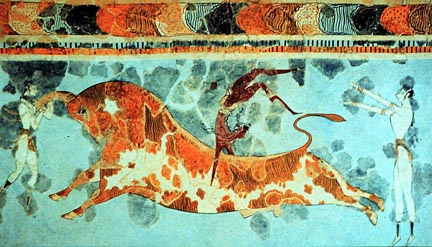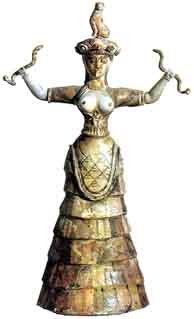Women in the Aegean
Minoan Snake Goddess
Christopher L. C. E. Witcombe
10. Women in Minoan Culture
There is plenty of archaeological evidence to indicate that women occupied an important if not dominant position within the practice of Minoan religion.
A principal goddess would appear to have been Potnia ("lady" or "mistress"). The name usually occurs, but not always, with some qualification such as Potnia of Grain, Potnia of Horses, or Potnia of the Labyrinth. Potnia may have been a female form of the male god Potidas or Poteidan, from which was later derived the name Poseidon (a Greek god closely associated with Crete in later times). A female form of Poseidon also occurs in the name Posidaija. Another goddess was apparently named Diktynna and another Britomartis ('Sweet Virgin').
Largely on the basis of what appear to be cult shrines and sanctuaries, the existence of other goddesses have been posited - a goddess of the caves, a tree goddess, a dove goddess, a snake goddess - but it remains unclear whether or not the Minoans worshipped them as individual, specialized divinities or as aspects of a single Great Goddess.
The predominance of goddesses (or of the Great Goddess) is attested to by the dominant role played by priestesses in religious ceremonies and the presence of women in ritual contexts. Women far outnumber priests and male attendants, for example, in the paintings on the four sides of the Aghia Triadha sarcophagus.
Moreover men are rarely seen in commanding positions, despite attempts to identify them in such positions. Even the lifesize male figure in the reconstructed frescoed stucco relief at Knossos which Evans identified as the "Priest-King" is now believed to be made up of fragments of several different figures. The only thing that seems relatively certain is that one or more of the figures was male.
Images of women occur more frequently than men in the Minoan archaeological record, both on Crete and in the more recent excavations on the island of Thera (Santorini). At both sites women are seen depicted in frescoes either alone or in groups.

"Toreador Fresco"
from the East Wing of the Court of the Stone Spout, Knossos
c. 1400 BCE. Fresco (restored)
(Archaeological Museum, Herakleion)
One of the most revealing images of the status of women in Minoan society is the famous "Toreador fresco" in which young women, shown with the conventional white skin, and darker-skinned men, engage in the dangerous sport that appears to involve somersaulting over the back of a charging bull.
Although it is difficult to decipher exactly what these figures are doing, the context and their proximity to the raging bull clearly denotes a game or ritual that involves bravery, agility, and skill, qualities which in any other contemporary eastern Mediterranean culture would have been thought of as residing exclusively within the domain of men. That they are being demonstrated also by young women in the Minoan fresco strongly suggests that on ancient Crete women occupied a significant place in society.
Excursus:
MATRILINY IN THE AEGEAN BRONZE AGE 
|

Minoan Snake Goddess
from Knossos, Crete
c. 1600 BCE
faïence
height 131/2 inches (34.3 cm)
(Archeological Museum, Herakleion)
Copyright © (text only) 2000
Christopher L. C. E. Witcombe
All rights reserved
|

